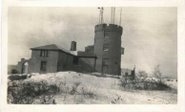Winter '12 / '13 - North Atlantic Oscillation: Long-range Signals and Long-term Trends
Up until a few years ago...the UKMET office issued a long-lead forecast of the North Atlantic Oscillation's (NAO) phase for the upcoming winter. The forecast was based on the correlation between May's sea-surface temperature anomalies (SSTA) in the western Atlantic ocean and the phase of the NAO. Geo-potential height anomalies at 500 mb in the same general region were also found to have predictive value.
They claimed these correlations had predictive value ~67% of the time...a far cry better than the brain-dean CW about how seasonal NAO forecasting is unpossible.

If May's SSTA matches the pattern in the western Atlantic ocean...then a +NAO is expected to be the dominant state during the upcoming winter. Above normal SST in the offshore waters of the NE coast...cold water SE of Iceland and warm anomalies to the northeast point toward a +NAO. If the pattern is reversed...then a -NAO is forecast.
---
This year...May's SSTA were a good match to the anomaly pattern shown above off the NE coast (1) but not so much elsewhere (2,3).
Area 1...the offshore waters of the NE...+SSTAs ==> +NAO
Area 2...SW of Iceland...+SSTAs ==> -NAO
Area 3...NE of Iceland...-SST anomalies ==> -NAO
SSTAs offer a decidedly mixed signal.
---
At 500 mb anomalies for MAY-12...
Positive height anomalies over western Europe ==> +NAO
The effect of a negative action center INVOF the Azores is unknown.
---
This winter's NAO signal based on the UKMET/s long-lead conceptual model is unambiguously ambiguous.
Sea-surface temperature anomalies off the NE coast suggest +NAO while SSTAs off the coast of Greenland suggest -NAO. Height anomalies at 500 mb over Greenland signal -NAO and a + NAO over western Europe. The effect of the Azores' strong negative signal is unknown.
Next up: Analogs
---
Earlier posts about the UKMET NAO forecast here.

























No comments:
Post a Comment